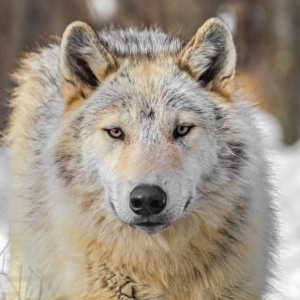 There is no scientific consensus about wolf subspecies. Recent studies related to morphology and genetic identification of wolf populations indicate issues with the subjectivity and scientific differences about wolf-subspecific designations. Due to these recent findings, the International Wolf Center will now refrain from designating our ambassadors by subspecies or by using wolf subspecific designations in its literature, except possibly to discuss questions about the subject itself. Many species are known to the public by various common names, for example, cougars are also called panthers, pumas, and mountain lions. Similarly, the wolf is often referred to as a timber wolf, tundra wolf, arctic wolf, lobo, and this naming usually carries a geographical or cultural context. It is not wrong to use such terms but should not be immediately assumed to be a separate taxonomic unit.
There is no scientific consensus about wolf subspecies. Recent studies related to morphology and genetic identification of wolf populations indicate issues with the subjectivity and scientific differences about wolf-subspecific designations. Due to these recent findings, the International Wolf Center will now refrain from designating our ambassadors by subspecies or by using wolf subspecific designations in its literature, except possibly to discuss questions about the subject itself. Many species are known to the public by various common names, for example, cougars are also called panthers, pumas, and mountain lions. Similarly, the wolf is often referred to as a timber wolf, tundra wolf, arctic wolf, lobo, and this naming usually carries a geographical or cultural context. It is not wrong to use such terms but should not be immediately assumed to be a separate taxonomic unit.
A study published in the Journal of Mammalogy (Khidas, 2023), argues for a single morphological pool of North American gray wolf populations (Canis lupus). Based on cranial morphological patterns of their sample (not including the southern region of the US), no single population can be characterized as unique, and no evidence was found to support geographic isolation of populations. Therefore, data collected do not support the previously reported subspecies of North American gray wolves, or the eastern wolf as a separate species.
Despite the lack of morphological evidence to support various North American gray wolf subspecies and the eastern wolf as a different species, genetic studies have found molecular evidence that suggests three wolf species in North America (Vilaca et al. 2023) : the red wolf (Canis rufus), the gray wolf (Canis lupus), and the eastern wolf (Canis lycaon).
The hybridization of Great Lakes area wolves with coyotes (Lehman et al. 1991) happened long enough ago that current Great Lakes wolves (including MN wolves) show no morphological coyote traits. Thus the only remaining indication of such hybridization is their mitochondrial DNA, so in our opinion, there is no case for the Great Lakes wolves being referenced as hybrids.
This is an important lesson about scientific discoveries. The more information we know, the more details may change. This doesn’t imply that past knowledge wastotally wrong. It implies that the knowledge we gain through improved methods, resources, and technology comes increasingly closer to the truth and will ensure that the future status of wolf nomenclature has a broad spectrum of analysis.
References:
Chambers SM, Fain SR, Fazio B, Amaral M. 2012. An account of the taxonomy of North American wolves from morphological and genetic analyses. North American Fauna 77:1–67. doi:10.3996/nafa.77.0001
Khidas, K. 2023. Morphological relationships among populations support a single taxonomic unit for the North American Gray Wolf. Journal of Mammalogy. https://doi.org/10.1093/jmammal/gyad012
Lehman, N., A. Eisenhawer, K. Hansen, L. D. Mech, R. O. Peterson, P. J. P. Gogan, and R. K. Wayne. 1991. Introgression of coyote mitochondrial DNA into sympatric North American gray wolf populations. Evolution 45(1):104-119.
Vilaça ST, Donaldson ME, Benazzo A, Wheeldon TJ, Vizzari MT, Bertorelle G, Patterson BR, Kyle CJ. 2023. Tracing Eastern Wolf Origins from Whole-Genome Data in Context of Extensive Hybridization. Molecular Biology and Evolution, 40(4). https://doi.org/10.1093/molbev/msad055

The International Wolf Center uses science-based education to teach and inspire the world about wolves, their ecology, and the wolf-human relationship.
